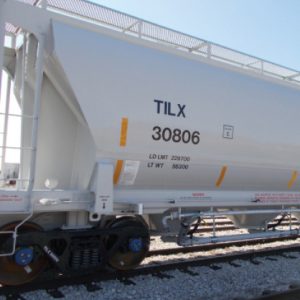While commercial operations are still scheduled to begin this spring, McInnis Cement is actively developing its distribution network. Construction of the Oshawa, Ontario, Canada, terminal began in late February, and continues with the start of operations scheduled for late summer 2017.

Formerly used for industrial port operations, the Oshawa site is already equipped with domes, two of which are currently being refurbished to include a cement unloading system for arriving vessels, and a truck loading station being constructed nearby. The two domes will provide a storage capacity of 14,000 metric tons of cement and the terminal will accommodate up to 60 trucks per day for loading and delivery to McInnis customers. The Oshawa terminal will be served primarily by the NACC Quebec, the vessel chartered by McInnis for distribution through the St. Lawrence Seaway.
Work is also underway at the company’s New York terminal. The site in the South Bronx is part of McInnis’ network of terminals strategically located throughout the eastern portion of North America and chosen for their access to efficient waterways as well as their proximity to the market to minimize truck miles to its customers.
 |
| Oshawa terminal. |
When completed, the 74,600-sq.-ft. terminal will feature a new warehouse that can store 43,000 tons of cement and load up to 80 trucks per day. Cement will be delivered to the Bronx from McInnis’ plant in Port-Daniel—Gascons, Quebec. A barge-mounted ship unloader travelling between New York and Providence will be used to pneumatically transfer the cement into the warehouse.
The facility will set a new standard for development in the New York City Harbor, featuring 24/7 operations to best serve its local market. A rooftop solar array will reduce strains on the local power and a fully enclosed truck loadout will mitigate dust. The around-the-clock operations in conjunction with the terminal proximity to concrete plants will dramatically reduce truck traffic and associated emissions in the Bronx, noted McInnis.
In the future, the area is expected to see more than $60 billion in infrastructure projects and another $7.7 billion in Superstorm Sandy repairs, creating a much-needed demand for concrete. The Bronx terminal will allow McInnis customers to participate in these projects while reducing their transportation costs and environmental impact.
 |
| Rendering of the Bronx terminal. |
In order to serve the needs of its customers via the rail network, McInnis acquired 25 new cars from TrinityRail. The pressure differential cars of 3,230 cu. ft. are designed to efficiently transport, load and unload dry material under tightly sealed conditions. The cars will be ready for loading cement at the New Richmond trans-shipment site at the start of commercial operations.
“As the work continues with the intensity required to start our plant operations on time, our team is working extremely hard to complete the final pieces of the puzzle for both logistics and distribution,” said McInnis Cement CEO Herve Mallet. “We are pleased to see that everything is in place to distribute our cement to our customers.”

